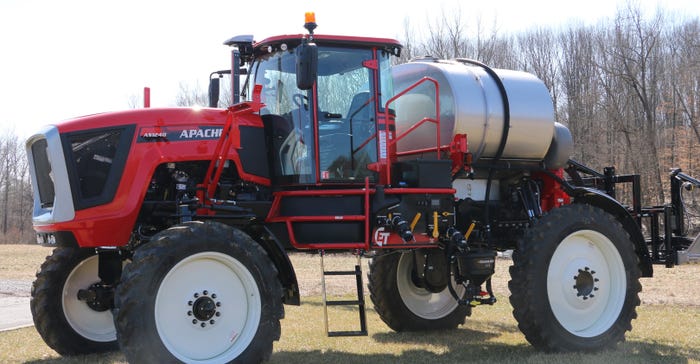
You can order sprayers with lots of bells and whistles. Which technologies do people ask about most?
Representatives from four companies report what they’re hearing:
Case IH. “One thing people want is GPS,” says Mark Burns, marketing manager for application equipment with Case IH. “Whether it’s basic GPS for basic WAAS [Wide Area Augmentation System], or RTK and autosteering, guidance is big,” he says. “Probably 70% of our sprayers go out with GPS today.”
Automatic boom-height control for changing terrain is also popular, Burns notes. “With changing terrain, they want to keep the boom the same height above the target,” he says. “If the boom drops too low, you may get skips. If it gets too high, drift becomes a bigger issue.”
The third technology growers want is pulse width modulation to maintain uniform droplet size even if driving speed varies. “We’ve offered it since 1998,” he says. “This technology delivers both a constant application rate and maintains uniform droplet size, even if driving speed changes.”
Equipment Technologies. This Mooresville, Ind.-based company makes Apache and Bruin sprayers. “Pulse width modulation is a hot trend,” Kevin Covey says. “It’s a nozzle control system which uses an electronic module on each nozzle to make sure the sprayer delivers the right rate over a range of speeds. It also delivers droplet control, which helps minimize drift.”
Covey says pulse width modulation can be a $20,000 to $30,000 option, depending on the size of boom.
Turn compensation is another feature people ask about. “The goal is to apply the same amount of product on the inside of the turn as on the outside,” he explains. “ET offers a full line of precision solutions on Apache and Bruin sprayers.”
John Deere. Curve compensation is also something growers tell John Deere spraying specialists they want. Deere addresses this need with its ExactApply spraying option. The goal is to avoid applying too much over part of the boom and not enough actual herbicide on the outer edges of a turn or curve.
Nozzle technology in general registers with most customers, Deere spokespeople note. Growers often seek advice to make sure they’re using the right nozzles for what they’re trying to accomplish. They want to achieve good coverage but minimize drift potential.
Growers also ask for row guidance. Deere offers an AutoTrac Vision Guidance option that uses cameras instead of an A-B line approach to help guide the sprayer across the field. This option can be retrofitted onto some later-model Deere sprayers.
RoGator by Agco. “Applicators want to deliver the right amount of product in the right place,” says David Fickel, manager of tactical marketing for Agco RoGator. “We accomplish it using our LiquidLogic system.”
The LiquidLogic system continuously recirculates the product solution through the boom, plumbing and filters, and controls flow to deliver what’s needed to the nozzle when it’s needed, he explains. Using front and side reload keypads, operators can load the right amount of spray needed per field and be confident they won’t run short or have excess spray left over to run out.
E-Stop nozzles with electric on-off valves are also available on the RoGator C Series, eliminating drips and providing instant shutoff to prevent overspray. Applicators also want to control banks of nozzles, Fickel says. The Raven Viper 4 controller provides control of 16 banks of nozzles.
To see photos of these products, check out the slideshow.
About the Author(s)
You May Also Like




